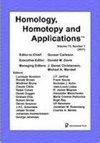Magnitude meets persistence: homology theories for filtered simplicial sets
IF 0.5
4区 数学
Q2 MATHEMATICS
引用次数: 0
Abstract
The Euler characteristic is an invariant of a topological space that in a precise sense captures its canonical notion of size, akin to the cardinality of a set. The Euler characteristic is closely related to the homology of a space, as it can be expressed as the alternating sum of its Betti numbers, whenever the sum is well-defined. Thus, one says that homology categorifies the Euler characteristic. In his work on the generalisation of cardinality-like invariants, Leinster introduced the magnitude of a metric space, a real number that counts the “effective number of points” of the space and has been shown to encode many invariants of metric spaces from integral geometry and geometric measure theory. In 2015, Hepworth and Willerton introduced a homology theory for metric graphs, called magnitude homology, which categorifies the magnitude of a finite metric graph. This work was subsequently generalised to enriched categories by Leinster and Shulman, and the homology theory that they introduced categorifies magnitude for arbitrary finite metric spaces. When studying a metric space, one is often only interested in the metric space up to a rescaling of the distance of the points by a non-negative real number. The magnitude function describes how the effective number of points changes as one scales the distance, and it is completely encoded by magnitude homology. When studying a finite metric space in topological data analysis using persistent homology, one approximates the space through a nested sequence of simplicial complexes so as to recover topological information about the space by studying the homology of this sequence. Here we relate magnitude homology and persistent homology as two different ways of computing homology of filtered simplicial sets.大小满足持久性:过滤简单集的同调理论
欧拉特征是拓扑空间的一个不变量,在精确意义上,它捕获了其规范的大小概念,类似于集合的基数。欧拉特征与空间的同调密切相关,因为它可以表示为其贝蒂数的交替和,只要这个和是定义良好的。因此,有人说,同调分类欧拉特征。在他关于类基数不变量的推广工作中,伦斯特引入了度量空间的幅值,这是一个计算空间“有效点数”的实数,并被证明可以从积分几何和几何测量理论中编码度量空间的许多不变量。2015年,Hepworth和Willerton引入了度量图的同调理论,称为幅度同调,它对有限度量图的幅度进行了分类。这项工作随后被伦斯特和舒尔曼推广到丰富的范畴,他们引入的同调理论对任意有限度量空间的范畴量进行了分类。在研究度量空间时,人们通常只对度量空间中点的距离用一个非负实数重新标度感兴趣。大小函数描述了有效点数随距离的变化情况,完全由大小同源性编码。利用持久同调研究拓扑数据分析中的有限度量空间时,通过简单复形的嵌套序列来逼近空间,从而通过研究该序列的同调来恢复空间的拓扑信息。本文将大小同调和持久同调作为滤波简单集的两种不同的计算同调的方法。
本文章由计算机程序翻译,如有差异,请以英文原文为准。
求助全文
约1分钟内获得全文
求助全文
来源期刊
CiteScore
1.10
自引率
0.00%
发文量
37
审稿时长
>12 weeks
期刊介绍:
Homology, Homotopy and Applications is a refereed journal which publishes high-quality papers in the general area of homotopy theory and algebraic topology, as well as applications of the ideas and results in this area. This means applications in the broadest possible sense, i.e. applications to other parts of mathematics such as number theory and algebraic geometry, as well as to areas outside of mathematics, such as computer science, physics, and statistics. Homotopy theory is also intended to be interpreted broadly, including algebraic K-theory, model categories, homotopy theory of varieties, etc. We particularly encourage innovative papers which point the way toward new applications of the subject.

 求助内容:
求助内容: 应助结果提醒方式:
应助结果提醒方式:


